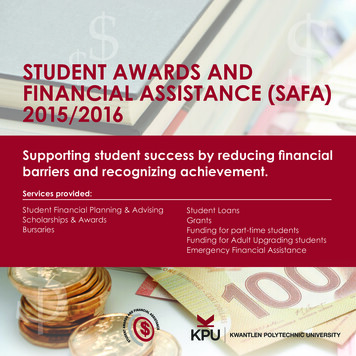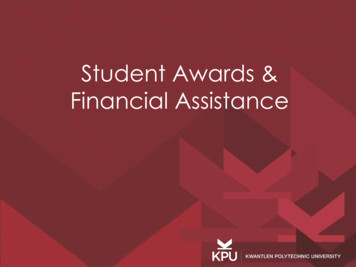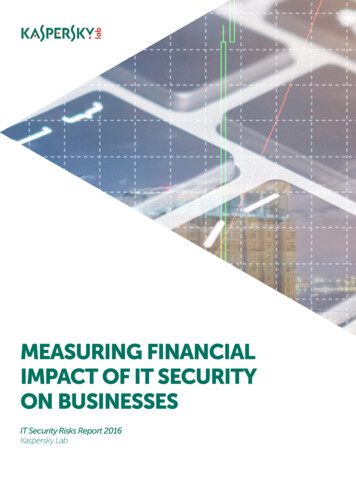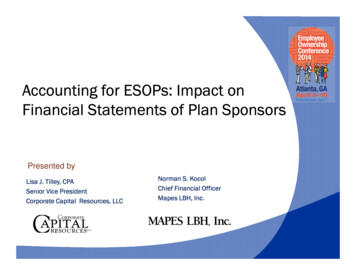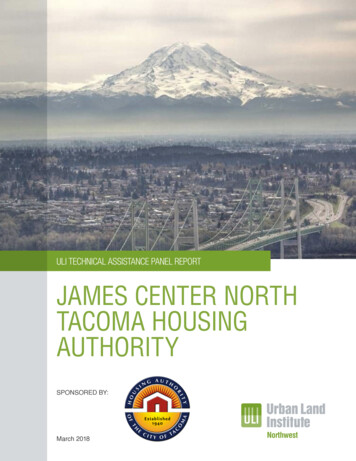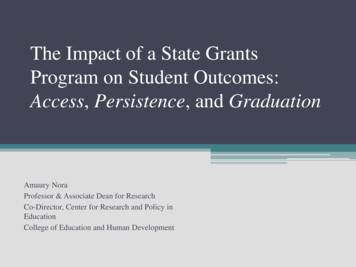
Transcription
The Impact of a State GrantsProgram on Student Outcomes:Access, Persistence, and GraduationAmaury NoraProfessor & Associate Dean for ResearchCo-Director, Center for Research and Policy inEducationCollege of Education and Human Development
The Importance of Financial Aid A key barrier to college access and completion forminorities and low-income students is financial. Affordability landscape is dramatically different forthese students. Priced out of college because disadvantaged by: High rates of povertyLimited financial, academic, and social capitalHigh levels of unmet financial needHigh risk of accruing unmanageable debtFinancial illiteracy
Financial Aid and the Public Americans believe that earning a postsecondary degree is important for themajority of individuals. Many are concerned about equity gaps in college access for low-incomefamilies, citing large numbers of low-income students who are motivated toenroll in college but are not able to do so because of financial challenges. “While many Americans say that major changes are needed in higher education, our researchdebunks the idea that the public has started to doubt whether college is still worth it," saidGeoff Garin, president of Hart Research Associates. “African American and Hispanic parentsin particular have high aspirations for their children to graduate college. For them, thequestion is not whether college is worth it but whether college success is attainable undertoday's circumstances." New polling results reveal a strong public interest in making the student aidsystem work better for students and families at a time when the studentbody is becoming increasingly diverse.
Financial Aid: Research Findings on Financial Aidand Student Outcomes Research evidence substantiates that financial aid has bothtangible (receipt of aid to offset college costs) and intangible(reduction of stress and development of positive academicand social attitudes) benefits. Studies demonstrate that receiving financial aid is associatedwith college persistence, academic performance, degreeattainment and transfer.
Financial Aid and Student Persistence Research evidence substantiates the importance offinancial aid within the student persistence process. Cabrera, Nora, & Castaneda, 1993Chen & DesJardins, 2007Crisp & Nora, 2010Curs & Singell, 2002DesJardins, Ahlburg, & McCall, 2002Gross, 2011Nora, 1990Nora, Barlow, & Crisp, 2006Olivas, 1985Singell, 2004Castleman & Long, 2013Gross, Torres, & Zerguera, 2013
Financial Aid and Student Persistence(cont.) These findings address the direct, indirect, and totaleffects of financial aid on student re-enrollment: Tangible component of receiving financial aid Receipt of aid to offset college costs Amount of financial aid received Different sources of financial assistance Intangible benefits associated with receiving financial aid Reduction in stress Development of positive academic and social attitudes Money for books, housing, tuition, entertainment
Positive Impact on Different StudentOutcomes Academic performance: cumulative grade point average Cabrera, Castaneda, Nora & Hengstler, 1992 Woo & Choy, 2011 Transfer from two- to four-year institutions Crisp & Nora, 2010 Woo & Choy, 2011 and Undergraduate degree attainment: BAs Dynarski, 2003, 2005
Why College Affordability is Critical forCertain Groups High rates of poverty are reducing their ability to afford, as well asto complete college. It is important to note where students attend college. Lower tuition charges at two-year institutions but low rates of degreecompletion and transfer For example: 45.8% of degrees earned by Latino students were earned at public, fouryear colleges 22.4% of degrees earned by Latino students were earned at public twoyear colleges The relationship between class and educational attainment points tostark inequalities between the rich and the poor, a point longsubstantiated in research studies (Adelman, 2004; Reardon, 2011).
Why College Affordability is Critical forCertain Groups (contd.) Texas’ college-age population is growing rapidly andexperiencing an influx of students from low-incomefamilies with few financial resources, and no historyof participation in higher education. The state must effectively distribute limited TEXASgrant awards to an increasingly diverse andfinancially needy student population.
TEXAS Grant Program The TEXAS (Towards Excellence, Access andSuccess) Grant program was established to providefunds to academically prepared high school graduateswith financial need to pursue a higher education. Has played a vital role in helping the state achieve thegoals of Closing the Gaps by 2015 in bothparticipation and success. Attempts to improve participation and successthrough its requirements of students for initial awardsand eligibility for continuation in the program.
Research Findings Participation since 1999 – roughly 460,592 studentshave received an award FY 2010 Number of grant recipients by income level TEXAS Grant recipients in the lowest two incomequintiles (less than 45,000 family income) accountedfor approximately 80% of recipients. Total recipients: 68,075 Hispanics: 29,790 (43.8%) African American: 9,621 (14.1%) White: 13,683 (20.1%)
Research Findings TEXAS Grants in 2010-2011 106,000 students received a grant TEXAS Grants in 2012-2013 77,000 students received a grant TEXAS Grants FY 2000 – 2015 460,592 students received grants - 3,313,296,152 awarded Harris County: 112,198 - 448,857,088 awarded Cuts to TEXAS Grant Program: Leave students and families more dependent on loans andworking even more during school Lengthen the time to completion or non-completion who lack theresources for college Impact school choice for many low-income students wishing toenroll in a four-year institution
Recent Research: Impact of State Grants onPersistence and Graduation (2016 AERA Conference)Conceptual FrameworkStudy built on the Heterogeneous Research Approach (Chen, 2008;Perna, 2006) to account for influential aspects on student success Incorporated aspects from literature in economics, sociology, andorganizational behavior For estimation of propensity scores and controls in HGLM estimationHuman capital theory (Becker,1962) and price response theory(Heller, 1997) for aid effectsStudent-level and institutional-level influences on student successmeasures (Titus, 2004, 2006)
Recent Research: Impact of State Grants onPersistence and Graduation Results confirm positive effects for state need-based grants onstudent success (both persistence & completion) Stronger evidence on 1st-year persistence and 6-year completion(help to keep students in and graduate, but not necessarily ontime) Low-income students (ATET) 7.7% on six-year graduation ( 4.6% for all) 4.6% on 1st-year persistence ( 3.1% for all) Significant positive effects for middle income studentsconfined to freshman year persistence Implications for relevance of state aid (awareness) and policy(need vs. merit aid; overall funding; targeting)
Research on State Aid Grants: EmpiricalStudies Bettinger, E. (2015). Need-based aid and collegepersistence: The effects of the Ohio CollegeOpportunity Grant Student’s dropout rates fell by 2% as a result of theprogram. Increased likelihood that students attend 4-yearcampuses. Increase in first-year grade point averages. Based on an 800 increase in grant aid
Research on State Aid Grants: EmpiricalStudies (Selective public university) Clotfelter, C.T., Hemelt, S.W., & Ladd, H.F. (2016).Multifaceted aid for low-income students and collegeoutcomes: Evidence from North Carolina. Increased four-year graduation rates by 8 percentagepoints. Increased persistence rates over four years. Increase in cumulative earned credits. Increase in academic performance. Aid programs targeting low-income, high-abilitystudents are most successful when they couple grant aidwith strong non-financial supports.
Texas Grant ProgramRedefiningAccessLinda Ballard, TAFSAA Legislative Representative &TSU Director, Student Financial Assistance
Texas Grant Program New Grant Program – major expansion of state-funded financialassistance. Performance Based Merit Aid –All financial aid programs havean academic requirement to retain the aid. The existing conceptof satisfactory academic progress was broadened to ensure thestudent moved toward graduation in a consistent pattern. Initial and Continuing Award Criteria – consistent from school toschool. Students know and understand what is expected of themto receive and retain their award. Renewable Based on Academic Performance With the exception of the Federal Pell Grant, the Texas Grant isone of the few programs providing a renewable financial resourceover multiple terms of the student’s undergraduate enrollment.
Gathering Information Providing consistent reliable information to the students and community is keyto the success of the program. How will the awarding institutions identify the students who qualify for theprogram? How will the students know about the program? High School TranscriptsFree Application for Federal Student AidExisting Data on Financial Aid Management SystemTexas Grant used existing data in a new format to develop the candidate pool. Texas Association of Student Financial Administrators provides High School Counselor Training Workshops – timeliness and accuracy of information. Partnered with the Texas Higher Education Coordinating Board to provide training, refinereporting requirements, disseminate information to the public through multiple mediaoutlets. Shared policies and procedures, recommendations for best practices
2013-2014 – Significant ProgramChanges March 1 State Priority Deadline Texas Grant Priority Model In addition to the basic eligibility requirements, students must meetrequirements in at least 2 of the following 4 areas for priorityconsideration: Allows veterans who enlist within 12 months of graduation fromhigh school to complete for an initial year award
Financial Impact – Choice andWithdrawal Texas Grant increases the likelihood the students will graduate. They find that increases in need-based financial aid likely improved studentretention. Other work by Singell (2001) looks at the effects of the level offinancial aid in the first year. He finds that the higher the student’s levels ofneed-based financial aid, the more likely the student is to graduate.(HowFinancial Aid Affects Persistence, p. 213) Providing predetermined renewable awards decreases the student’slikelihood to withdraw and enhances the student’s ability to plan for thefuture. With covariates, the estimated coefficient implies that a 1,000 increase in astudent’s Pell Grant corresponds to a 9.2 percentage point decrease in thelikelihood that the student withdraws. These estimates suggest strongly andconsistently that increases in financial aid decrease the likelihood thatstudents withdraw from school. (How Financial Aid Affects Persistence, p.222)Volume ISBN:0-226-35535-7, “College Choices: The Economics of Where to Go, When to Go and How toPay for It” National Bureau of Economic Research, Publication, “How Financial Aid Affects Persistence”
Financial Impact – Choice and AcademicSuccessFree Tuition ProgramsThe Texas Grant programs provides more opportunity to leveragelimited funding in innovative ways.15 Colleges in Texas currently offer a Free Tuition ProgramFreeTuition Federal Pell Grant Texas Grant Institutional Dollars (1)The reality is many of the student’s earnings are an integral part of the household budget.“Students are most likely to state that work limits their class schedule (48 percent), followed bythe number of classes they take (40 percent), class choice (34 percent), and access to facilities (31percent).”(2) (Ace Issue Brief, “Working Their Way Through College.”)For students who work, however, working more than part time does seem to have anegative impact on grades at most types of institutions. At public and private not-forprofit four-year institutions, those who work one to 20 hours per week do slightly better,on average, than those who do not work at all. However, as the number of hours spentworking increases, the average GPA for students who work declines modestly.The Texas Grant Program affords students the opportunity to reducework hours by reducing the additional costs to the householdexpenses as part of the costs to attend college.(1) Retrieved from ef-2006-Working-their-way-throughCollege.pdf(2) Retrieved from https://www.uta.edu/ubmathsci/apps/Tuition.pdf
TASFAA Embracing Access and DegreeCompletion Ensure continued access to low and middle-income families toa higher education Embrace proposals that 1) encourage on-time graduationfrom college and 2) ensure the most effective use of limitedTEXAS Grant fundsReinforcing retention and degree completion 12 hours as a minimum. This approach allows for some enrollment flexibility, ensuresenhanced progress to degree completion and utilizes aid funds to more effectiveadvantage in assisting (at least as determined by enrolled hours) fully engaged students.Respecting the target audience 15 hours as a minimum full-time definition for the program, but this suggestion is a causefor concern. Need-based students, who need the funding, are often the least prepared totake larger course loads initially. Further, it is inherently unfair to treat need-basedstudents differently than those students without need (i.e., by only requiring need-basedstudents to enroll in 15 hours each semester).
TASFAA Recommendations Fully Fund the TEXAS Grant Program TASFAA strongly supports fully funding the TEXAS Grant program as the best wayfor the state to achieve its higher education goals regarding participation andsuccess. Though TASFAA realizes that fully funding the program may be feasible, iturges the Legislature not to adopt program changes that limit access among lowand middle-income families to a higher education. Restrain from Shrinking the Population of Eligible Recipients. Before the Legislature again considers establishing new programs that will reducefunding for existing programs (which are largely well-designed in terms of the mixof grants, loans, and work-study), it should use appropriations to move toward fullyfunding the programs already in existence. These are established programs, thoughcurrently under-funded, are designed to provide financial assistance to all eligiblestudents. It should also not shrink the eligible population by adding additionalmerit-requirements to the TEXAS Grant, Tuition Equalization Grant or Be-OnTime programs.
Transparent Equitable AllocationProcesses TASFAA – How will the changes affect Texas’ abilityto meet the needs of the continuing, newly definedand previously established populations. College presidents were vested in ensuring funds remaincommitted to serving underrepresented academicallyprepared populations. Legislature, sustained commitment to deliveringeducational opportunity to students. Texas Grant and Financial Aid Databases allow predictivemodeling based on proposed changes.
Funding the Eligible Population If funds remain after all eligible priority students – who met the prioritydeadline – have been awarded, the balance of allocated funds can go tothose students who met just the basic TEXAS Grant requirements. No school’s share of funds will be reduced or increased because of the prioritymodel system. Funds for initial year awards will continue to be distributed among institutionsbased on each institution’s share of the eligible needy student population andreturning Texas Grant recipients. Recommended target amounts to increase the number of Texas 8.16.pdf
Stemming the Tide of Rising StudentDebt According to the 2015 How America Pays for Collegestudy,2 38% of students attending college in the 20142015 academic year are borrowing money to do so (orhaving family borrow money on their behalf). Themajority of this money comes from loans from the federalgovernment, representing 60% of borrowing for the2014-2015 (1) Four years ago, student loan debt in America topped 1trillion. Today, that number has swelled even further,with some 43 million Americans feeling the enduringgravity of 1.3 trillion in student loan debt. (2)(1) The Debt Divide: The Racial and Class Bias Behind the “New Normal” of Student Borrowing.Retrieved from g(2) (2) Why Student Loan Debt Harms Low-Income Students the Most, para -student-loan-debt-harms-low-incomestudents-most/
Stemming the Tide of Rising StudentDebt According to the Federal Reserve report, a family inthe lowest income quintile—which has an averagefamily income of 17,011 (while the highest quintilehas an average family income of 173,474)—wouldhave pay more than 70 percent of the family incometo cover college costs after accounting for grant aid.Yes, 70 percent! (Families in the four remainingquintiles would have to pay 36 percent, 27 percent,21 percent, and 14 percent, respectively.) (1) Less likely to have family assistance to repay the loan Have limited or not parental financial support Likely to have more family and work obligations(1) U.S. News, Education Rapidly Rising Student Debt, Harms Low-Income Students, para ms-low-income-students
Texas Grant – a model program The type of aid matters The evidence from our review demonstrates that allforms of grants, in most instances, have a positiveinfluence on student persistence. The cumulative evidence suggests that both grantsand college work-study have a greater positiveimpact on persistence than loans. When we isolate the unique effects of merit- and need-based grants, both types of aid appear to have a morepositive impact than shown in studies that treat all forms of grant as a single variable. The studies that lookseparately at both forms of grants primarily use institutional data sets as opposed to state or national datasets, and this may at least in part explain why we found these differences. It is important to state explicitlyour finding that the receipt of larger amounts of financial aid has a greater positive impact onpersistence than smaller amounts of aidThough the record is limited, we found evidence that points to the conclusion that large, visible, and easyto understand financial aid programs have a small positive effect on student persistence whencompared with programs that provide similar amounts of money but through multiplesources (multiple forms of grants, subsidized and unsubsidized loans, and college work-study)
Student PerspectivesFabiola Varela –Houston Community CollegeMorgan V. McAllister –University of Houston-Downtown
Thank You!Q&A
Free Tuition Programs The Texas Grant programs provides more opportunity to leverage limited funding in innovative ways. 15 Colleges in Texas currently offer a Free Tuition ProgramFree Tuition Federal Pell Grant Texas Grant Institutional Dollars (1) The reality is many of the student




